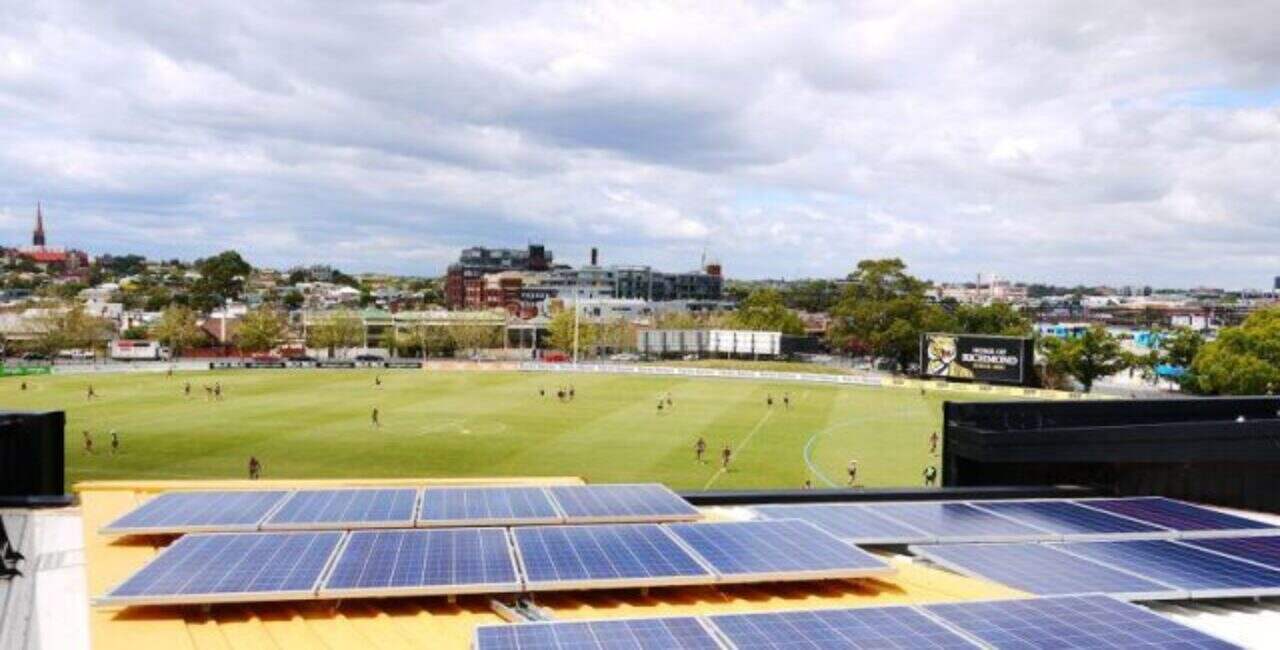
Sports is big business. In fact, the global sports market was estimated to be worth a massive 487 billion U.S. dollars in 2022. So, it is no surprise that the leaders and businesses behind sports are often at the cutting edge of new technologies.
In this article, we explore how solar technology is and will continue to make sports more sustainable, helping inspire athletes and fans to make a positive change in the world.
Sporting events can often have high energy demands.
Large-scale stadiums where sports like football, rugby and athletics take place will require high levels of energy to run. This can include everything from lighting and HVAC systems to electronic displays and sound systems. For example, lighting a stadium during a night game could use in the region of 800 to 5000 kilowatts of electricity alone.
When powered by traditional fossil fuel-generated energy, this can be incredibly costly and harmful to the environment.
This is where solar comes in…

Solar installations are already commonplace in many stadiums across the globe. This is largely due to their affordability and the large volume of roof space afforded to stadiums.
For example, the Golden 1 Center in Sacramento, California (home to the Sacramento Kings) has a 1.2 MW solar array located on-site as well fulfilling the rest of their energy requirements from an 11 MW solar farm run by the Sacramento Municipal Utility District. In Atlanta, the Mercedes Benz Stadium houses 4000 solar panels on its roof. In Amsterdam, the Johan Cruijff Arena has 4200 panels along with 3MW of storage facilitated by old and new vehicle batteries.
In the UK, there are plans to invest £4 million into installing solar panels on the roof of West Ham’s Londons Stadium. This project is expected to take two years complete and is predicted to pay for itself within 5 years of operation.
Although stadiums arguably provide the biggest opportunity for solar, they aren’t the only aspect of sports that can benefit from solar-generated electricity. For example, Formula E (similar to Formula 1, but with electric cars) is a clear area where solar could be used in the execution of the sport itself.
Although solar has played a role in Formula E in the past, mostly due to the solar power available within its host location, it is not yet an established aspect. This is a clear opportunity, offering a potentially sustainable alternative to racing which requires the burning of fossil fuels. In fact, Formula E has released a statement highlighting their plans to power their events from 100% renewable sources.
Innovative gyms are also looking to solar power to support their energy needs. For example, Eco Gym in Rochester, New York has an innovative approach to energy production - using indoor cycling equipment to capture energy from your workout which is then turned into electricity for the building.
However, this doesn’t quite fulfil their full energy needs, so the building is also equipped with a 26-kilowatt rooftop solar PV system and 2 8.9-kilowatt wind turbines.
Of course, a shift from traditional fossil fuel-generated power to solar energy in any sport isn’t without its challenges.
There are many individuals and businesses that invest heavily in sports purely to make a profit. Although solar panel prices have dropped significantly in recent years, they are still no small investment, especially on the scale required to facilitate major sporting events and stadiums.
Luckily, it is easy for long-term investors to see the benefit of solar power, with panels often paying for themselves within 5-10 years.
Depending on where they are located, some sports stadiums may also have to overcome challenges with gaining permission to install solar panels. This is especially true in cases where panels are being retrofitted to an already established location.
For example, in some US states permission is required to install any panels. Yet in the UK, in most cases, installing panels comes under ‘permitted development’ meaning you do not need permission to install them.
Luckily, in more recent years local and national governments have come under pressure to facilitate renewable energy production, which has made it easier in many cases.

There are several benefits of installing solar panels in sports.
Arguably cost saving is the driving factor behind the uptake of solar in many cases. Initial investments eventually drive a strong ROI as energy bills drastically reduce or are removed from the equation altogether.
However, sustainability also plays a big role. Even if the organisation behind the sports don’t personally see the benefit of investing in solar from an ethical point of view (although most do), doing so can drastically enhance their public image and help supporters feel better about spending on the sports they love.
There are several exciting innovations in solar technology which could have a significant impact on solar in sports.
For example, developments in Building-Integrated Photovoltaics (BIPV) are making it easier than ever to build solar panels directly into building materials such as those used for roofs and facades. Clear solar panels are also being widely tested. These are exciting given the potential to integrate them into stadiums that rely on large surface areas of glass.
Tandem solar cells are also an exciting area of research which promises to drastically increase the efficiency of solar panels by 50-75 per cent. This could open many doors in the sporting world, making it easier to go 100% renewable whilst meeting the huge energy demands of stadiums and large-scale sporting events.
Solar power already plays an important role in improving the sustainability of sports, helping investors reduce costs and generate better ROI. This trend is likely to continue into the coming years as fans, athletes and governing bodies increase pressure for more sustainable processes and locations.
It is clear that due to its massive popularity around the globe, sports will play an important role as we collectively move towards ambitious carbon targets, such as Net-Zero 2050.













